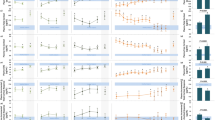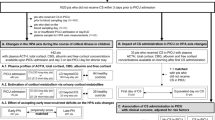Abstract
Purpose
To study the value of free versus total cortisol levels in assessing relative adrenal insufficiency during critical illness-related corticosteroid insufficiency.
Methods
A prospective study in a mixed intensive care unit from 2004 to 2007. We consecutively included 49 septic and 63 non-septic patients with treatment-insensitive hypotension in whom an adrenocorticotropic hormone (ACTH) test (250 μg) was performed. Serum total and free cortisol (equilibrium dialysis), corticosteroid-binding globulin (CBG) and albumin were assessed.
Results
Although a low CBG resulted in a high free cortisol level relative to total cortisol, free and total cortisol and their increases were well correlated (r = 0.77–0.79, P < 0.001). In sepsis, hypoalbuminemia did not affect total and free cortisol, and increases in total cortisol upon ACTH predicted increases in free cortisol regardless of low binding proteins. In non-sepsis, total cortisol was lower with than without hypoalbuminemia; free cortisol did not differ, since hypoalbuminemia concurred with a low CBG. Increases in total cortisol depended less on binding proteins than on raw levels. The areas under the receiver operating characteristic curve for predicting increases in free from total cortisol were 0.93–0.97 in sepsis and 0.79–0.85 in non-sepsis (P = 0.044 or lower for sepsis vs. non-sepsis).
Conclusions
Although the biologically active free cortisol fraction depends on binding proteins, total cortisol correlates to free cortisol in treatment-insensitive hypotension during critical illness. In sepsis, albumin is not an important binding molecule. Subnormal increments in total cortisol upon ACTH suffice in assessing relative adrenal insufficiency, particularly in sepsis.

Similar content being viewed by others
References
Arafah BM (2006) Hypothalamic pituitary adrenal function during critical illness: limitations of current assessment methods. J Clin Endocrinol Metab 91:3725–3745
Annane D, Sebille V, Charpentier C, Bollaert PE, François B, Korach JM, Capellier G, Cohen Y, Azoulay E, Troché G, Chaumet-Riffaud P, Bellissant E (2002) Effect of treatment with low doses of hydrocortisone and fludrocortisone on mortality in patients with septic shock. JAMA 288:862–871
Marik PE, Zaloga GP (2003) Adrenal insufficiency during septic shock. Crit Care Med 31:141–145
Hamrahian AH, Oseni TS, Arafah BM (2004) Measurements of serum free cortisol in critically ill patients. N Engl J Med 350:1629–1638
Annane D, Maxime V, Ibrahim F, Alvarez JC, Abe E, Boudou P (2006) Diagnosis of adrenal insufficiency in severe sepsis and septic shock. Am J Respir Crit Care Med 174:1319–1326
de Jong MFC, Beishuizen A, Spijkstra JJ, Groeneveld AB (2007) Relative adrenal insufficiency as a predictor of disease severity, mortality, and beneficial effects of corticosteroid treatment in septic shock. Crit Care Med 35:1896–1903
Sprung CL, Annane D, Keh D, Moreno R, Singer M, Freivogel K, Weiss YG, Benbenishty J, Kalenka A, Forst H, Laterre PF, Reinhart K, Cuthbertson BH, Payen D, Briegel J, CORTICUS Study Group (2008) Hydrocortisone therapy for patients with septic shock. N Engl J Med 358:111–124
Pugeat M, Bonneton A, Perrot D, Rocle-Nicolas B, Lejeune H, Grenot C, Déchaud H, Brébant C, Motin J, Cuilleron CY (1989) Decreased immunoreactivity and binding activity of corticosteroid-binding globulin in serum in septic shock. Clin Chem 35:1675–1679
Bonte HA, van den Hoven RJ, van der Sluijs Veer G, Vermes I (1999) The use of free cortisol index for laboratory assessment of pituitary-adrenal function. Clin Chem Lab Med 37:127–132
Beishuizen A, Thijs LG, Vermes I (2001) Patterns of corticosteroid-binding globulin and the free cortisol index during septic shock and multitrauma. Intensive Care Med 27:1584–1591
Dhillo WS, Kong WM, Le Roux CW, Alaghband-Zadeh J, Jones J, Carter G, Mendoza N, Meeran K, O’Shea D (2002) Cortisol-binding globulin is important in the interpretation of dynamic tests of the hypothalamic-pituitary-adrenal axis. Eur J Endocrinol 146:231–235
Le Roux CW, Sivakumaran S, Alaghband-Zadeh J, Dhillo W, Kong WM, Wheeler MJ (2002) Free cortisol index as a surrogate marker for serum free cortisol. Ann Clin Biochem 39:406–408
Vogeser M, Briegel J, Zachoval R (2002) Dialyzable free cortisol after stimulation with SynacthenR. Clin Biochem 35:539–543
Le Roux CW, Chapman GA, Kong WM, Dhillo WS, Jones J, Alaghband-Zadeh J (2003) Free cortisol index is better than serum total cortisol in determining hypothalamic-pituitary-adrenal status in patients undergoing surgery. J Clin Endocrinol Metab 88:2045–2048
Ho JT, Al-Musalhi H, Chapman MJ, Quach T, Thomas PD, Bagley CJ, Lewis JG, Torpy DJ (2006) Septic shock and sepsis: a comparison of total and free plasma cortisol levels. J Clin Endocrinol Metab 91:105–114
Christ-Crain M, Stolz D, Jutla S, Couppis O, Müller C, Bingisser R, Schuetz P, Tamm M, Edwards R, Müller B, Grossman AB (2007) Free and total cortisol levels as predictors of severity and outcome in community-acquired pneumonia. Am J Respir Crit Care Med 176:913–920
Christ-Crain M, Jutla S, Widmer I, Couppis O, König C, Pargger H, Puder J, Edwards R, Müller B, Grossman AB (2007) Measurement of serum free cortisol shows discordant responsivity to stress and dynamic evaluation. J Clin Endocrinol Metab 92:1729–1735
Dorin RI, Pai HK, Ho JT, Lewis JG, Torpy DJ, Urban FK 3rd, Qualls CR (2009) Validation of a simple method of estimating plasma free cortisol: role of cortisol binding to albumin. Clin Biochem 42:64–71
Poomthavorn P, Lertbunrian R, Preutthipan A, Sriphrapradang A, Khlairit P, Mahachoklertwattana P (2009) Serum free cortisol index, free cortisol, and total cortisol in critically ill children. Intensive Care Med 35:1281–1285
Sweeney DA, Natanson C, Banks SM, Solomon SB, Behrend EN (2010) Defining normal adrenal function testing in the intensive care unit setting: a canine study. Crit Care Med 38:553–561
Bendel S, Karlsson S, Pettilä V, Loisa P, Varpula M, Ruokonen E, Finnsepsis Study Group (2008) Free cortisol in sepsis and septic shock. Anesth Analg 106:1813–1819
de Jong MF, Beishuizen A, Spijkstra JJ, Girbes AR, Groeneveld AB (2007) Relative adrenal insufficiency: an identifiable entity in nonseptic critically ill patients? Clin Endocrinol (Oxf) 66:732–739
Cameron A, Henley D, Carrell R, Zhou A, Clarke A, Lightman S (2010) Temperature-responsive release of cortisol from its binding globulin: a protein thermocouple. J Clin Endocrinol Metab 95:4689–4695
Holland PC, Hancock SW, Hodge D, Thompson D, Shires S, Evans S (2001) Degradation of albumin in meningococcal sepsis. Lancet 357:2102–2104
Vogeser M, Groetzner J, Briegel J (2003) Free serum cortisol during the postoperative acute phase response determined by equilibrium dialysis liquid chromatography-tandem mass spectrometry. Clin Chem Lab Med 41:146–151
Vogeser M, Möhnle P, Briegel J (2007) Free serum cortisol: quantification applying equilibrium dialysis or ultrafiltration and an automated immunoassay system. Clin Chem Lab Med 45:521–525
Briegel J, Sprung CL, Annane D, Singer M, Keh D, Moreno R, Möhnle P, Weiss Y, Avidan A, Brunkhorst FM, Fiedler F, Vogeser M, CORTICUS Study Group (2009) Multicenter comparison of cortisol as measured by different methods in samples of patients with septic shock. Intensive Care Med 35:2151–2156
Acknowledgments
We thank Alderick N. Panneflek, Ingrid van den Hul and Erna Alberts for technical support.
Author information
Authors and Affiliations
Corresponding author
Electronic supplementary material
Below is the link to the electronic supplementary material.
Rights and permissions
About this article
Cite this article
Molenaar, N., Johan Groeneveld, A.B., Dijstelbloem, H.M. et al. Assessing adrenal insufficiency of corticosteroid secretion using free versus total cortisol levels in critical illness. Intensive Care Med 37, 1986–1993 (2011). https://doi.org/10.1007/s00134-011-2342-x
Received:
Accepted:
Published:
Issue Date:
DOI: https://doi.org/10.1007/s00134-011-2342-x




